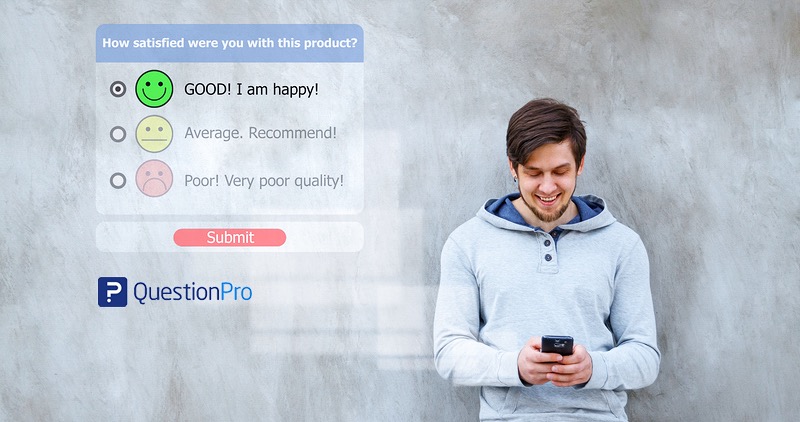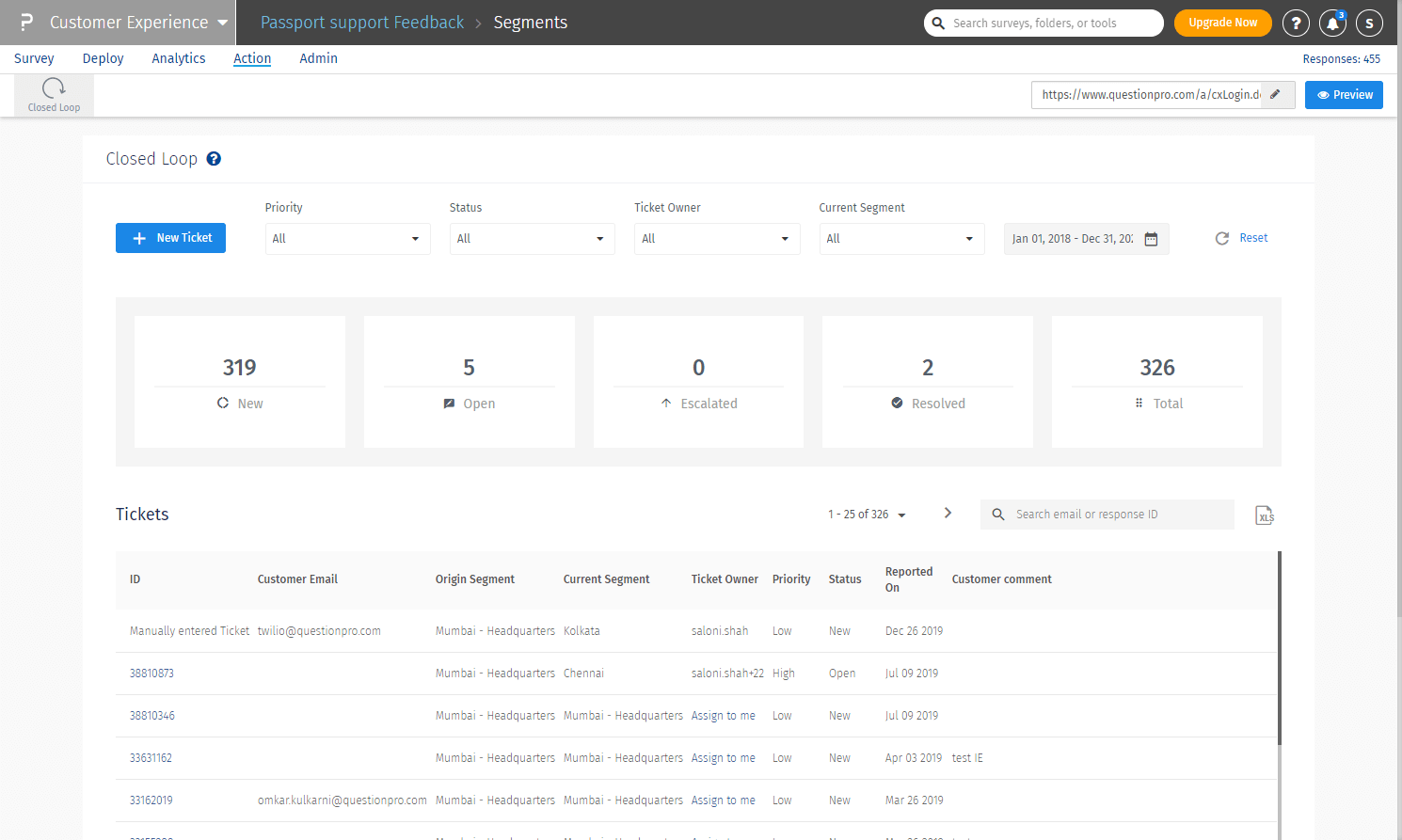Customer Experience Management
Communicate with your dissatisfied customers before they post negative feedback on social networks or rating portals. To do this, you need to be in constant dialogue with your customers. QuestionPro's CX software offers a closed loop feedback system for this purpose.
Closed loop feedback system
- 1 The challenge: React before criticism reaches the social networks
- 2 The solution: A closed loop feedback system
- 3 These are the most important advantages of closed loop feedback
- 4 1:1 Live Online Presentation: Closed Loop Feedback System from QuestionPro
- 5 Try software for market research and experience management now for 10 days free of charge!
The challenge: React before criticism reaches the social networks
Disgruntled customers vent via social media or review portals when they dislike a product, a service or the after-sales service. However, this often happens only when dissatisfied customers receive no or only inadequate answers when they complain. As a rule, misunderstandings or actual shortcomings can be clarified before invective comments make it to the public. By then, however, it is usually too late: customers leave and the negative feedback is visible to the public, which in turn influences the purchasing decisions of other consumers. This does not have to be the case. If you maintain a lively and constant exchange with your customers and give them the opportunity to contact your company quickly and easily via all media, you can react to criticism and annoyance directly within the framework of a 1:1 dialogue, appease or satisfy the customer and thus avoid a public complaint.
The solution: A closed loop feedback system
Closed loop feedback means that your employees remain in a dialogue with their customers until challenges from their customers are actually solved or the dialogue is completed.
A simple example: A customer gets his goods delivered to his home, unpacks them and notices that the product is damaged. Now the customer is naturally annoyed and tries to reach the customer service. If no one is available or if the problem is played down and even exchange is denied, it is most likely that the customer will make this negative experience public. However, if the employees of your company respond to the angry customer, offer an exchange or a free repair, this incident will hardly reach the public and you will have been able to keep a customer.
Don't wait for feedback, stimulate it!
To ensure that your customers contact you before public criticism occurs, you should always keep in touch with your customers, and do so proactively! In the above example, a QR code could be placed on the product packaging with the information that customers can contact customer service immediately in case of dissatisfaction. After scanning the QR code, customers are then directed to a landing page where they can contact you directly. Ideally, your customers can also upload pictures of the damaged product here. Now a feedback loop (closed loop feedback) can start until the customer is satisfied. If the customer is actually satisfied, you can then ask them an NPS question with the option of sharing the positive customer experience with your company on social media or rating portals. This is how you turn disgruntled customers into real promoters for your products and brands!
→ Make positive feedback visible
→ What is Net Promoter Score (NPS)
Define closed loop feedback processes
In order for feedback processes to work smoothly, you need to ensure that they are defined and known to all staff from the beginning. Give your employees all possible competences to be able to react quickly and appropriately to complaints and criticism. Every employee must know exactly what to do in the event of a complaint or criticism. Here you will find tips on how to deal with dissatisfied customers: → Measure and increase customer satisfaction.
Use a closed loop ticket system
Ideally, your company uses CX software that helps your employees comply with closed loop feedback processes. QuestionPro's CX software has a closed loop ticket system that allows you to define and monitor closed loop feedback processes. For example, the system shows you all open, solved, unresolved or failed tickets clearly within a ticket dashboard. You also receive an analysis.
QuestionPro's Closed Loop Feedback system allows you to define feedback processes based on different criteria. Thus, it is possible that a customer who gives you a negative NPS rating is immediately given the opportunity to contact your company or can ask for your company to contact the customer. The system then automatically creates a ticket. Depending on the customer touchpoint at which the ticket is triggered, it is forwarded to the appropriate departments and persons for processing according to previously defined routines.
 A closed loop feedback system helps you to respond quickly to customer feedback and to better and more directly understand your customers' experiences from their perspective. The insights gained from the closed loop tickets can also be incorporated into your long-term customer experience strategies.
A closed loop feedback system helps you to respond quickly to customer feedback and to better and more directly understand your customers' experiences from their perspective. The insights gained from the closed loop tickets can also be incorporated into your long-term customer experience strategies.
These are the most important advantages of closed loop feedback
A closed feedback loop is essential for any business that is truly sustainable in customer loyalty and takes a customer-centric approach. Your customers will have more confidence in your company and your products, which in turn will encourage customer loyalty. Loyal customers are vital to the success of any business. They promote your brand, make repeat purchases regularly, identify strongly with your company and want you to succeed in the long term.
- Strengthening customer loyalty: In today's world, it has become very difficult to retain customers. There are countless competing products and brands on the market. This poses great challenges for companies to create customer loyalty. Brand loyalty is rather low compared to the past due to availability and interchangeability. When brands close the feedback loop with their customers, they provide a positive experience and a lasting impression. Customers feel valued and this strengthens customer loyalty. The more positive your customers' experiences are, the more loyal they become.
- Increase the competence of your employees: With a closed-loop mechanism, you can optimise the performance of your employees. With a closed-loop feedback mechanism, employees receive specific information that helps them learn to identify problems, fix them and avoid them in the future. Managing customer feedback helps employees understand the problem and its urgency and find the best solution.
- Reduce negative word of mouth: PwC has conducted a customer study that shows that 32% of all customers would not buy a product or brand again after a single negative experience. This has a significant impact on your customer churn figures. Customers are more likely to talk about a negative experience with colleagues or loved ones than a positive experience. Positive customer experiences are critical to brand reputation and loyalty. This can be ensured by listening to your customers and not leaving any dialogue open. It's fine if you can't find a solution to your customers' problems, but acknowledging a problem and working towards solving it is key to customer satisfaction. Your customers will appreciate this and it helps to foster loyalty and minimise negative customer sentiment.
- Increase company sales: Closed loop customer feedback helps you identify roadblocks along the customer journey and take the necessary steps to address them. By consistently collecting customer feedback and using it to improve your customer processes and initiatives, you can improve the customer experience in the long term, significantly increase customer satisfaction and increase customer loyalty. Loyal customers improve a brand's business through repeat purchases and referrals from new customers.
- Automate feedback processes: A clever closed loop feedback system is able to automate feedback processes completely and according to certain criteria. Thus, you will not lose any customer feedback, not even "by mistake". Due to the automation of feedback processes, your employees can fully concentrate on the content of customer enquiries and complaints and do not have to deal with rules on how an enquiry is forwarded or dealt with.
1:1 live online presentation:
Closed loop feedback system from QuestionPro
Dealing quickly with complaints and criticism from dissatisfied customers can help a company retain these customers and turn them into loyal buyers in the future. Closed-loop feedback is a systematic cycle in which a company's way of working is significantly changed based on customer feedback. It is an incredibly powerful tool to communicate to customers in a personal way that their opinion is highly valued. We would be very happy to show you how to implement a true closed loop feedback system with QuestionPro during a live 1:1 demo!
Make an individual appointment now.
Try software for market research and experience management now for 10 days free of charge!
Do you have any questions about the content of this blog? Simply contact us via contact form. We look forward to a dialogue with you! You too can test QuestionPro for 10 days free of charge and without risk in depth!
Test the agile market research and experience management platform for qualitative and quantitative data collection and data analysis from QuestionPro for 10 days free of charge
FURTHER KEYWORDS
SHARE THIS ARTICLE
KEYWORDS OF THIS BLOG POST
Closed loop | Feedback | Ticket | System | CX
FURTHER INFORMATION
- Complaint management software from QuestionPro
- Market research: examples, tips, data collection, data analysis, software for carrying out and presenting the results
- The big QuestionPro-Guide on the subject of customer surveys: definition, development, methods, examples, evaluation, template for import.
- Customer Experience Management: Tips, Tools, Best Practices
- Reputation management: tips, software, app




